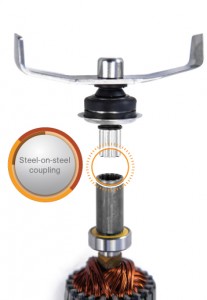Anatomy of a Blender, Part 6

Let's dive once again into the inner workings of Blendtec blenders. This time, we're going to look at In which we examine a true masterpiece of engineering.
Feature #10: Steel-on-Steel Power
In a Blendtec blender, the power is transferred directly from the motor to the blade. All the intervening parts are steel and machined for a precision fit. This steel-on-steel approach results in lower vibration, reduced noise, and increased reliability.
Blendtec's steel-on-steel power train is more reliable, lasts longer, and can transfer greater loads to the blade. In nearly all other blenders, the power goes from the motor through a breakable plastic coupling. The coupling is designed to break if the motor overloads, in order to protect the motor. Unfortunately, this design also limits blending power and decreases the life of the coupling.
A typical blender motor includes a plastic breakable coupling, which limits power transfer from the motor and reduces jar life.[/caption] A Blendtec blender, on the other hand, automatically detects an overload condition and shuts down, eliminating the need for a breakable plastic coupling. Have you ever noticed whether your blender has a breakable plastic coupling? If so, now you know why! Share your thoughts in the comments section below.




Is there anyway to reverse the direction of the motor (from clockwise to counter-clockwise)?
We just got our Total Blender last week. Wow. Awesome machine, We’re still getting used to it but compared to the now-dead one, it’s smaller, quieter and MUCH more powerful. The Ninja finally failed when a small screw (about 1/8 inch diameter) snapped. This was the fastener that held in place the plastic piece that transferred the power from the motor base to the blending jar. The all-metal drive train on the Total Blender is looking better all the time.
We have destroyed, at last count, 8 blenders (not Blendtec) in the past 3 years – all due to the failure of the plastic/rubber coupling. The sound of the over-revving motor, the smell of burned plastic and the mess of half-blended ingredients signal the machine’s demise. What can we say? Our kids love smoothies with lots of frozen fruit. Our current blender is on borrowed time but the local retailer has been replacing it so we’ve kept going back. The 1-year warranty is almost up and we know we aren’t going to get another. In researching the replacement I found that a lot of commercial blenders have plastic couplings that are designed to break – one manufacturer even ships a spare coupling with the blender. The idea of an ‘all steel’ powertrain really appeals to us so we’re off to Costco for a Blendtec when our current Ninja finally commits hara-kiri.
Hi Marit,
Please give our customer service a call at 800.748.5400. They will be able to best help you resolve this issue.
Hmmm, my NEW blendtec (only 38 minutes on it) said “overload” this morning when I put on my usual frozen blueberries, yogurt, milk and protein powder (it was on smoothie) . It was quite runny liquid… almost like water. Then I unplugged it, plugged it back in, turned off the back, turned it on on pulse …. and it still went to “overload”… so I emptied it, filled it with water… and it STILL went to overload (on pulse)…. then I put it on soups and sauces and it finally stayed on that cycle (with water) and didn’t go to overload.
Do I have a “bum” machine???? Should I take it back to Costco?
Thank you so much, Sincerely, Marit.
Leave a comment